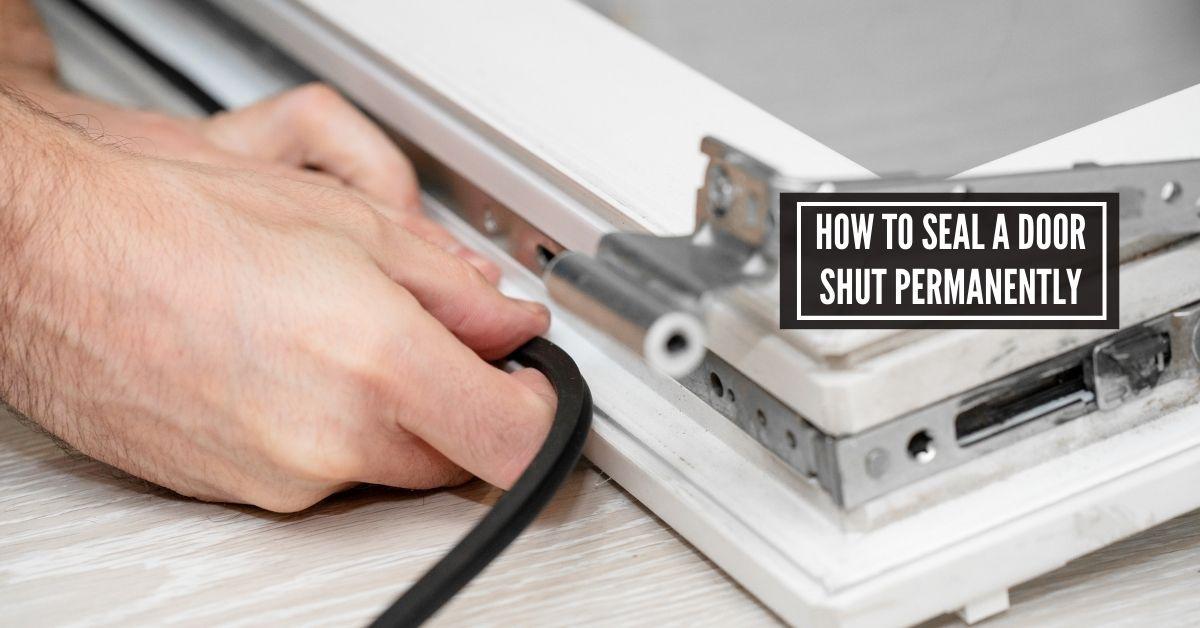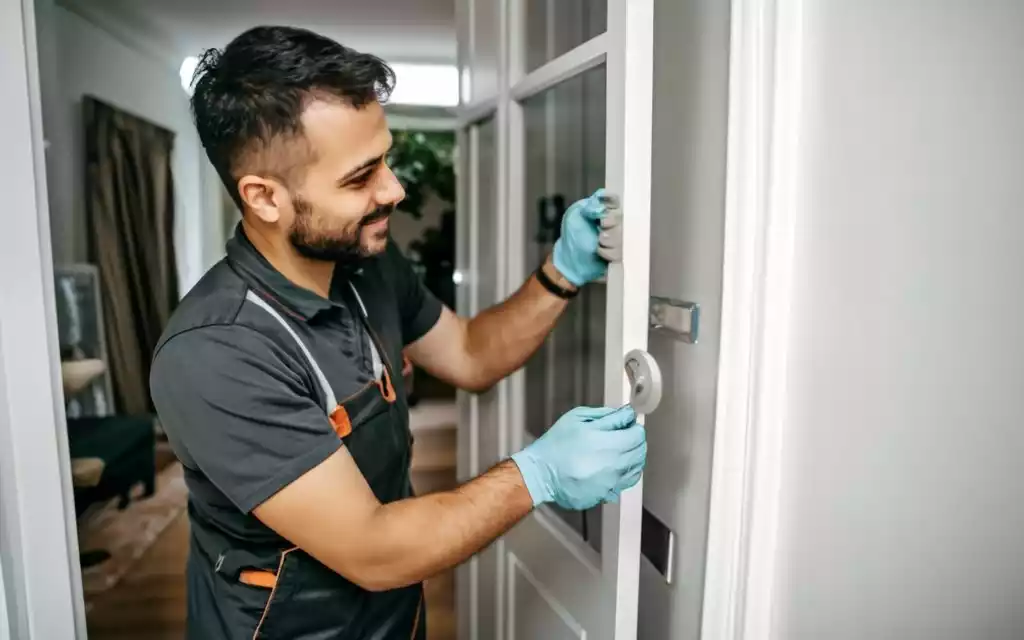How to Seal a Door Shut Permanently: Without Taking the Door Out

To seal a door shut permanently, remove the hardware and seal it with a combination of strong adhesive, caulk, and wood. Ensure a tight seal by also using foam insulation before finishing with paint or drywall.
Sealing a door permanently requires meticulous attention to detail and the right materials. Homeowners may choose to seal doors for various reasons, such as enhancing insulation, creating more wall space, or simply because the door is no longer necessary. Accurate methods and high-quality sealing products result in a long-lasting closure that blends seamlessly with the surrounding wall.
A solid sealant job not only improves the aesthetic appeal of a room but also contributes to energy efficiency. The process should always be approached with safety in mind, and all products should be used according to their instructions. Once sealed, the door will become an indistinguishable part of the wall, ensuring that the space remains undisturbed and effectively repurposed.
Pro Tips To Sealing A Door Permanently
Sometimes the need arises to seal off a door for good. This could be due to numerous reasons, from renovations and security enhancements to energy efficiency improvements. Knowing how to properly seal a door can save time and resources while ensuring that the job is done right.
Understanding The Reasons For Sealing A Door Shut
Various factors could lead to sealing a door:
- Operational changes in building use
- Structural modifications and space reconfiguration
- Creating barriers against pests and weather elements
- Need for improved insulation
- Strengthening privacy and security
Assessing The Long-term Implications Of A Permanent Seal
Before moving forward, consider the long-term effects:
| Implication | Details |
|---|---|
| Structural Integrity | Check that alterations do not compromise stability |
| Resale Impact | Understand potential resale value changes |
| Legal Considerations | Ensure compliance with local building codes |
| Ventilation | The area must maintain adequate air flow |
Preparation: Before You Start
Preparation sets the foundation for permanently sealing a door. Start with a plan. Gather the right tools and materials. Understand safety procedures. Measure the doorway accurately. With thorough preparation, sealing a door becomes an efficient and enduring process.
Preparation sets the foundation for permanently sealing a door. Start with a plan. Gather the right tools and materials. Understand safety procedures. Measure the doorway accurately. With thorough preparation, sealing a door becomes an efficient and enduring process.
Tools And Materials Required For Sealing A Door
Before sealing a door shut, ensure you have the following:
- Hammer or nail gun
- Screws and a screwdriver or drill
- Sealant or caulk with caulking gun
- Construction adhesive
- Plywood or drywall sheets (depending on the method)
- Utility knife for trimming
- Safety goggles and gloves
- Chisel or pry bar to remove the door
- Dust mask for protection against particles
Safety Considerations And Protective Equipment
Working safely is crucial. Always wear safety goggles and gloves to protect your eyes and hands. A dust mask will prevent inhalation of harmful particles. Keep a first-aid kit nearby in case of emergencies. Make sure the workspace is well-ventilated.
Measuring And Planning: Ensuring A Proper Fit
Accurate measurements are essential. Use a tape measure to get the doorway’s height and width. Add extra inches for the sealing material’s overlap. Plan to cover the entire doorframe. Choose a sturdy material to seal the opening effectively. Draft a plan on paper for reference during the process.
4 Easy Steps to Permanently Seal a Door
Welcome to our step-by-step guide on sealing a door shut permanently. Maybe you want to repurpose a room or just eliminate an unnecessary entrance. Whatever the reason, this guide will walk you through the process, ensuring a professional and lasting seal.
1. Removing The Door And Door Hardware
- Unscrew the hinges from the door frame.
- Remove the door by lifting it off the hinges.
- Take out any remaining hardware, such as locks or handles.
- Fill the holes left by hardware with wood putty.
2. Filling The Gap: Choosing Between Solid Fillers Or Drywall
To fill the doorway:
- Measure the doorway gap.
- Choose a filler: for smaller gaps use expandable foam, for larger ones use wooden planks or drywall.
- Secure the filler material with screws for stability.
- Apply a layer of joint compound over the filler for a smooth finish.

3. Creating A Permanent Seal: Techniques And Best Practices
- Ensure the joint compound is evenly applied.
- Allow each layer to dry before sanding.
- Check for gaps and seal with caulk if necessary.
4. Finishing Touches: Sanding, Painting, And Aesthetic Considerations
For a seamless look:
- Sand the dry joint compound until smooth.
- Clean the dust before painting.
- Paint over the sealed door to match the wall color.
- Consider wall texture to blend the old door space with the surrounding area.
Alternative Methods For Permanent Door Sealing
Sealing a door shut permanently is a task that sometimes becomes necessary for security, privacy, or to create a solid wall where a door used to be. Whether due to renovation projects or structural changes, you have various alternative methods to achieve a permanent seal. Explore some robust solutions beyond the standard wooden board-up technique.
Sealing a door shut permanently is a task that sometimes becomes necessary for security, privacy, or to create a solid wall where a door used to be. Whether due to renovation projects or structural changes, you have various alternative methods to achieve a permanent seal. Explore some robust solutions beyond the standard wooden board-up technique.
Using Concrete For Industrial Or Heavy-duty Sealing
User concrete when you need a bulletproof seal. Suitable for factories or buildings requiring high security, concrete fills the doorway and cures to become part of the wall.
- Measure the door frame.
- Build a wooden form inside the frame.
- Mix and pour concrete into the form.
- Allow time to dry and cure completely.
Brick And Mortar Solutions For A Permanent Fix
Bricking up a door can match existing walls and gives a classic, sturdy fix. It’s perfect for residential spaces or heritage buildings. Follow these steps for a seamless look:
- Remove the door and frame.
- Layer bricks and mortar to fill the gap.
- Ensure bricks align with the existing wall pattern.
- Finish with mortar for weather-proofing.
Advantages And Drawbacks Of Non-traditional Sealing Methods
| Method | Advantages | Drawbacks |
|---|---|---|
| Concrete | Extremely secure and permanent. | Demanding labor; not easy to remove. |
| Brick and Mortar | Visually appealing; durable. | Time-consuming; requires masonry skills. |
Both methods ensure a permanent seal with high security and endurance. Yet, they require more time and effort compared to temporary fixes. Consider these factors to choose the best method for your needs.
Maintenance And Future Proofing
Sealing a door shut permanently requires careful planning and execution. But it doesn’t end there. Regular maintenance ensures the seal remains intact and future-proofing protects against changes. This section covers key strategies for long-term care and compliance.

Long-term Maintenance Of A Sealed Door Space
A well-maintained seal keeps a door impermeable for years. Regular checks prevent small issues from becoming big problems. Here are simple steps to maintain your sealed door:
- Clean the sealed area to remove dust and debris.
- Check for wear and tear every few months.
- Reapply sealant if necessary to ensure a tight seal.
Inspecting And Repairing Cracks Or Leaks Over Time
Even the best seals can develop cracks or leaks. Inspecting your sealed door space helps catch these early. Addressing them promptly is crucial:
- Examine the seal twice a year for any signs of damage.
- Use high-quality caulk to repair minor cracks.
- For larger issues, consider professional assistance.
Ensuring A Safe And Secure Seal
‘Conclusion: Ensuring a Safe and Secure Seal’ marks the final stage of our guide. A permanent seal on a door provides both safety and peace of mind. Let’s ensure that seal is robust and enduring.
Recap Of Main Points Covered In The Article
We’ve explored essential steps to sealing a door permanently:
- Choose the right sealant for a tight bond.
- Prepare the door and frame for a clean adhesive surface.
- Apply the sealant carefully for an airtight closure.
- Allow ample drying time for a lasting seal.
Final Thoughts On The Permanence And Safety Of Sealed Doors
Sealed doors must offer unwavering safety. A strong sealant becomes a barrier. It keeps unwanted elements out. Permanent seals also lower risks from accidental openings.
Practice caution during the sealing process. Your door will become a steadfast guardian of your space. Remember, a permanently sealed door means commitment. Make sure you truly need to block off the space before taking action.
Frequently Asked Questions
How Do You Seal An Unused Door?
To seal an unused door, remove the hardware and seal gaps with caulk. Cover the door with insulation foam board, then seal edges with tape. Paint or cover for aesthetics.
How Do You Seal A Door To Keep Water Out?
Install weather stripping around the door to create a water-tight seal. Apply a sweep at the door’s base. Seal gaps with caulk. Use a threshold for the bottom. Add storm doors for extra protection.
How Do You Air Proof A Door?
To airproof a door, install weatherstripping around the edges, apply a door sweep or draft stopper at the bottom, and use caulking to seal any gaps. Ensure all components fit snugly to prevent air leaks.
How Can I Seal My Door Gap?
Measure your door gap and select an appropriate sealant, such as weatherstripping or a door sweep. Clean the door surface, then peel and stick the sealant, or screw in the door sweep for a tight fit. This will effectively seal your door gap.
What Materials Seal Doors Permanently?
To permanently seal a door, use materials like silicone caulk, epoxy, foam sealants, and wooden or metal planks for reinforcement.
Conclusion
Sealing a door shut permanently is straightforward with the right tools and steps. Ensure safety and proper materials for a secure seal. Remember, this is a lasting solution; double-check if it’s the best choice for your space. Need help? Consult a professional for advice or assistance.
Your doorway to peace of mind is now complete and enduring.

I am Robert Sandin, a professional sealing expert with a diverse range of expertise. From concrete to various other materials, I possess in-depth knowledge and experience in the art of sealing. On my website, I offer valuable tips and expert recommendations on sealing techniques and products for different materials. Whether it’s concrete, wood, metal, or more, I am committed to providing you with the guidance you need for successful sealing projects.
